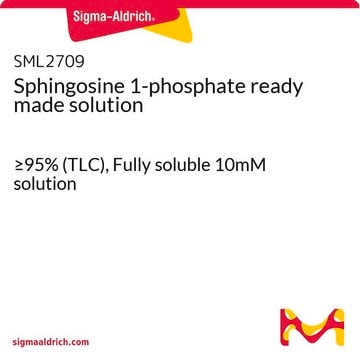860492P
Avanti
Sphingosine-1-Phosphate (d18:1)
Avanti Research™ - A Croda Brand
Synonym(s):
D-erythro-sphingosine-1-phosphate
About This Item
Recommended Products
form
powder
packaging
pkg of 1 × 1 mg (860492P-1mg)
pkg of 1 × 25 mg (860492P-25mg)
pkg of 1 × 5 mg (860492P-5mg)
manufacturer/tradename
Avanti Research™ - A Croda Brand
lipid type
sphingolipids
shipped in
dry ice
storage temp.
−20°C
SMILES string
[H][C@](/C=C/CCCCCCCCCCCCC)(O)[C@]([NH3+])([H])COP([O-])(O)=O
InChI
1S/C18H38NO5P/c1-2-3-4-5-6-7-8-9-10-11-12-13-14-15-18(20)17(19)16-24-25(21,22)23/h14-15,17-18,20H,2-13,16,19H2,1H3,(H2,21,22,23)/b15-14+/t17-,18+/m0/s1
InChI key
DUYSYHSSBDVJSM-KRWOKUGFSA-N
General description
Application
- as an internal standard in high performance liquid chromatography (HPLC) for the quantification of plasma lipid sphingosine-1-phosphate(S1P)
- to evaluate its chemotactic response of auto reactive immature B cells
- to test its effect on autophagy and preconditioning in oxygen and glucose deprived neurons
Biochem/physiol Actions
Packaging
Legal Information
also commonly purchased with this product
Storage Class Code
11 - Combustible Solids
WGK
WGK 3
Flash Point(F)
Not applicable
Flash Point(C)
Not applicable
Certificates of Analysis (COA)
Search for Certificates of Analysis (COA) by entering the products Lot/Batch Number. Lot and Batch Numbers can be found on a product’s label following the words ‘Lot’ or ‘Batch’.
Already Own This Product?
Find documentation for the products that you have recently purchased in the Document Library.
Customers Also Viewed
Our team of scientists has experience in all areas of research including Life Science, Material Science, Chemical Synthesis, Chromatography, Analytical and many others.
Contact Technical Service













